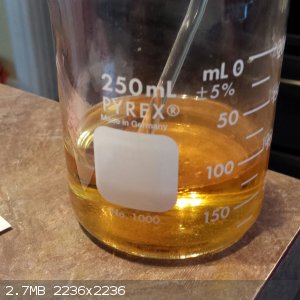
roXefeller - 10-2-2018 at 12:21
I attempted an acetate ester today. I can't find much information on resorcinyl monoacetate but a fair amount with phenyl acetate. From what I
understand, benzene diols are difficult to esterize unlike the alkanes. But first react with NaOH and then with the acid anhydride. So following
that method I dissolved 0.159 Mol of resorcinol with 100 mL of 2.5 Molar NaOH. I cooled this with ice and added 23.8 g acetic anhydride and stirred
virgorously. At the end I got a phase separation. The ester is supposedly 1.22 SG so I was looking for something heavy. The remaining products of
sodium acetate and acetic acid should have remained in the aqueous phase. But the aqueous phase has the honey color of resorcinyl acetate. The heavy
phase is precipitating like a white solid. I warmed up the separation funnel and found the heavy phase had melted. I drew this off and it is still a
liquid at room temp. But it has no smell about it. Not sure what I made. I haven't had a chance to check the boiling point of the lower phase but
it is only evolving a white vapor at 220F. Any ideas?
Magpie - 10-2-2018 at 14:17
I searched but could find no experimental data on resorcinyl monoacetate.
Resorcinol is 110g/100ml soluble in water. So, with an -OH group and an acetate group I am not surprised that it is soluble in water.
[Edited on 11-2-2018 by Magpie]
[Edited on 11-2-2018 by Magpie]
roXefeller - 10-2-2018 at 15:51
I considered that too so I added 20ml of ethanol, but it didn't make an appreciable change. Given the large amount of polar molecules currently in
the water, I'm not sure how much ester can dissolve. But that doesn't explain the precipitate. It continues to drop from solution. The bit I drew
off earlier and brought to 220F smells a bit like phenol/resorcinol, but not as strong.
Edit: I poured 10ml into a small graduated cylinder and it weighed 11.7g. It's slightly viscous, enough to entrain bubbles, faintly yellow, and
smells slightly of phenol. So it might be a good product. In the end I have almost 16g yield.
[Edited on 11-2-2018 by roXefeller]
DraconicAcid - 10-2-2018 at 15:57
I don't have any advice to add; I'm just suddenly curious about the properties of catechol oxalate.....
ETA: The molecule I'm thinking of would actually be phenylene oxalate. It can be made from catechol and oxalyl chloride : https://pubs.acs.org/doi/abs/10.1021/jo00403a048
[Edited on 11-2-2018 by DraconicAcid]
Magpie - 10-2-2018 at 17:09
I misread the Wiki on resorcinol. It is very soluble, ie, 110g/100mL in water. So the monoacetate should also be very soluble.
I will be making catechol from guiacol as soon as my damn overhead stirrer is repaired. At that time I can make some catechol acetate and determine
its properties.
roXefeller - 10-2-2018 at 18:12
The only thing I can find for the acetate solubility is 25g/L. That leaves around 6g in the aqueous phase.
roXefeller - 11-2-2018 at 13:10
So looking at resorcinyl acetate also brings up the possibility of a diacetate that isn't there for phenol. It has a 1.17 SG, so that's an option,
though it reduces my molar yield.
[Edited on 11-2-2018 by roXefeller]
Resorcinyl diacetate lab workup
roXefeller - 16-2-2018 at 18:53
60g resorcinol
316 ml water
79g NaOH
180g Acetic anhydride, Ac2O
In 500ml beaker stirred in ice water bath add water and NaOH keeping cool. Add resorcinol and stir until dissolved. Solution has translucent emerald
green color. Cool to 15C or lower. Add Ac2O in 10ml quantities allowing for cooling in between. Near the end of the additions the solution will
turn pink indicating a conversion of resorcinol. Return unused Ac2O to bottle. Stir for another 5 minutes. Aqueous phase is dense from sodium
acetate and acetic acid. Pour into 1000ml water and stir. Decant off top all but 250ml. Pour remaining liquid into separation funnel and allow to
settle. Water phase is mostly clear while heavy phase is milky. Draw off crude ester and discard the remaining water. Warm ester until milky color
goes away. Neutralize over sodium bicarbonate and calcium chloride. Filter solids. Nearly 90g, 85% yield. SG 1.17

